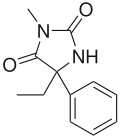Mephenytoin
 | |
|---|---|
| Systematic (IUPAC) name | |
| 5-ethyl-3-methyl-5-phenyl-imidazolidine-2,4-dione | |
| Clinical data | |
| AHFS/Drugs.com | Micromedex Detailed Consumer Information |
| MedlinePlus | a611020 |
| Pregnancy cat. | C (US) |
| Legal status | ? |
| Routes | Oral |
| Pharmacokinetic data | |
| Half-life | 7 hours |
| Identifiers | |
| CAS number | 50-12-4 |
| ATC code | N03AB04 |
| PubChem | CID 4060 |
| DrugBank | DB00532 |
| ChemSpider | 3920 |
| UNII | R420KW629U |
| KEGG | D00375 |
| ChEMBL | CHEMBL861 |
| Chemical data | |
| Formula | C12H14N2O2 |
| Mol. mass | 218.252 |
| SMILES
| |
| |
| | |
Mephenytoin (marketed as Mesantoin by Novartis) is a hydantoin, used as an anticonvulsant. It was introduced approximately 10 years after phenytoin, in the late 1940s. The significant metabolite of mephenytoin is nirvanol (5-ethyl-5-phenylhydantoin), which was the first hydantoin (briefly used as a hypnotic). However, nirvanol is quite toxic and mephenytoin was only considered after other less toxic anticonvulsants had failed. It can cause potentially fatal blood dyscrasia in 1% of patients.
Mephenytoin is no longer available in the US or the UK. It is still studied largely because of its interesting hydroxylation polymorphism.
References
- The Treatment of Epilepsy edited by S. D. Shorvon, David R. Fish, Emilio Perucca, W. Edwin Dodson. Blackwell Publishing. 2004. ISBN 0-632-06046-8
- The Medical Treatment of Epilepsy by Stanley R Resor. Published by Marcel Dekker (1991). ISBN 0-8247-8549-5.
- The Comparative Toxicogenomics Database: Mephenytoin
| ||||||||||||||||||||||||||||||||||||||||||||||||||||||||||||||||||||||||||||